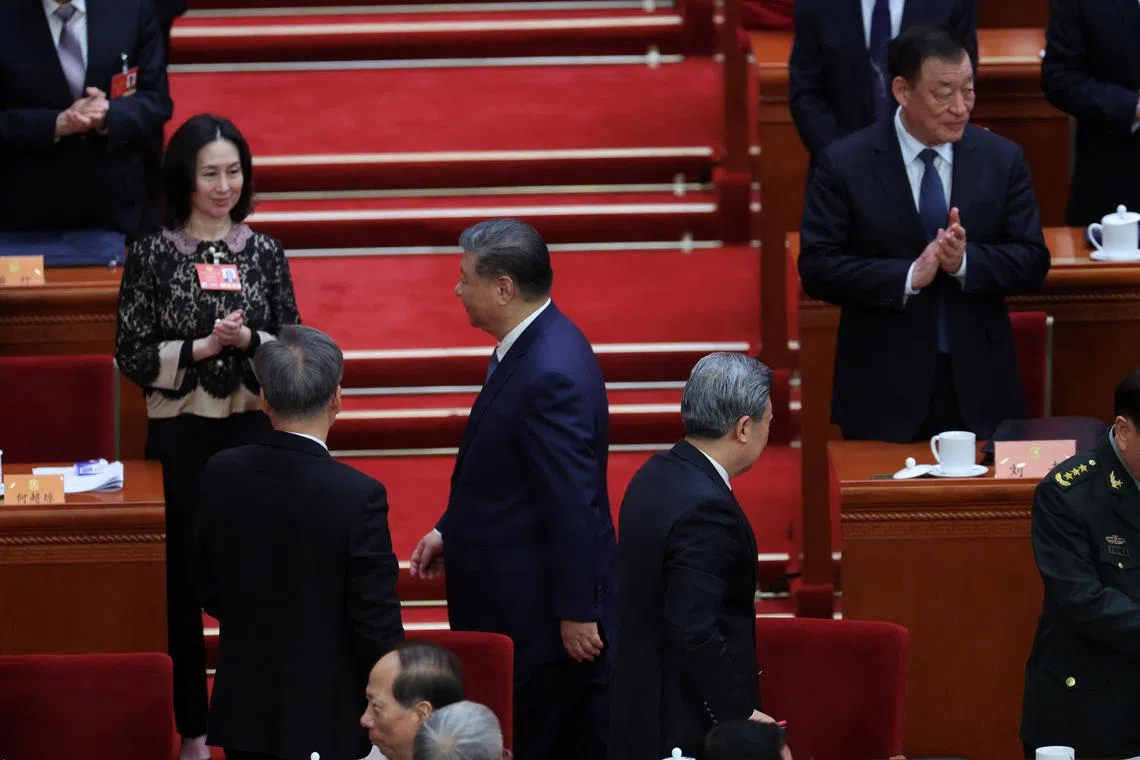China’s Parliament meets to shield economy from US tariff salvos
Sign up now: Get ST's newsletters delivered to your inbox

Chinese President Xi Jinping walking out at the end of the opening session of the Chinese People’s Political Consultative Conference in Beijing on March 4.
PHOTO: REUTERS
Follow topic:
BEIJING – China’s Parliament begins its annual session on March 5 with officials under pressure to tilt their fiscal resources towards consumers to make the economy more resilient in the face of rising US trade tariffs and deflationary pressures.
Having reached its 2024 economic growth target of roughly 5 per cent only with a late stimulus push, Chinese Premier Li Qiang is expected to lay out a similarly lofty, but even harder to reach goal for 2025 in front of the National People’s Congress.
An escalating trade war with US President Donald Trump’s administration is threatening to crimp China’s economic jewel, its sprawling industrial complex, at a time when persistently sluggish household demand and the unravelling of the debt-laden property sector are leaving the economy increasingly vulnerable.
Mr Trump has also dangled tariffs at a long list of countries, including some which would consider themselves staunch US allies, threatening a decades-old global trade order that Beijing has built its economic model around.
Pressure has been building on Chinese officials to introduce policies that put more money into consumers’ pockets and reduce the world’s second-largest economy’s reliance on exports and investment for growth.
Mr Li is expected to announce a higher budget deficit of 4 per cent of gross domestic product and record debt issuance. Some of these resources will help fund a recently expanded consumer subsidy scheme for electric vehicles, appliances and other goods.
But economists have been urging Beijing to engineer a long-term restructuring of resource allocation in the economy with more profound measures that reimagine its taxation, land and financial systems to weave a stronger social safety net.
“With deflationary pressures becoming entrenched against the background of an unfavourable external environment... boosting domestic household consumption demand is a key priority,” said Cornell University trade policy professor Eswar Prasad and a former China director at the International Monetary Fund.
“One-off schemes might help at the margin, but durable measures to provide income support and strengthen the safety net are essential.”
China’s 5 per cent growth rate in 2024 was among the world’s fastest, but it was hardly felt at street level.
While China runs a trillion dollar annual trade surplus, many of its people are complaining of unstable jobs and incomes as their employers cut prices – and business costs – to stay competitive in external markets.
Chinese producers, facing weak demand at home and harsher conditions in the US, where they sell more than US$400 billion (S$535 billion) worth of goods annually, have no choice but to rush to alternative export markets all at the same time.
They fear this would intensify price wars, squeeze their profitability, and raise the risk that politicians in those new markets will feel compelled to erect higher trade barriers against Chinese goods to protect domestic industries.
Since Mr Trump took office in January, his administration has so far added an extra 20 percentage points on existing import tariffs for Chinese goods, with the latest 10-point increment having kicked in on March 4.
“We worry that they will add another 10 per cent and then another 10 per cent,” said Mr Dave Fong, who manufactures school bags, talking teddy bears, stationery and consumer electronics in China. “That’s a big problem.”
China on March 4 swiftly retaliated against the fresh US tariffs, announcing 10 per cent to 15 per cent hikes to import levies
Since the pandemic, China has primarily placed its future growth bets on what it calls “new productive forces” rather than on its 1.4 billion consumers, pouring resources into advanced manufacturing, hoping to close the technological gap with geopolitical rivals.
Electric vehicle makers such as BYD and AI platform DeepSeek have taken to the world stage with plenty of pizzazz.
But Ms Alicia Garcia-Herrero, chief Asia-Pacific economist at Natixis, says technological aspirations and consumer demand growth are “competing priorities” and finding a balance between them “will be crucial for China to avoid the prolonged stagnation experienced by Japan”.
“The tangible impact of this innovation drive on growth, specifically through increased productivity, is not yet visible,” she said.
“While industrial policy and technological advancement are important, China must address its fundamental imbalances.” REUTERS

